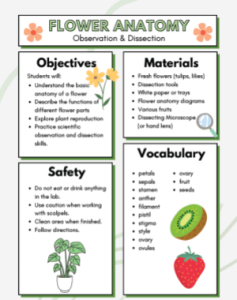
Flowers are not just beautiful to look at; they are also fascinating biological structures with distinct parts that play vital roles in the life cycle of plants. Understanding the anatomy of a flower is a fundamental part of any biology curriculum, and what better way to teach it than with a hands-on activity? Students will get an up-close view of a flower and explore the relationship between flowers and fruits.
The activity starts with the examination of a flower where students locate the petals, sepals, stamens and pistils. They sketch the flower and label the parts by referencing a diagram of the flower. You can use any type of flower that has both sexes. Many of the most iconic flowers, such as roses, lilies, and tulips, are bisexual, and the female pistil is characteristically surrounded by the male stamens. During each stage of the dissection, students answer questions about their observations as well as sketch the specimens.
In the next part of the activity, students remove the stamen and view with a dissecting microscope. They will then sketch and label the view, focusing on the anthers and individual pollen grains. Then, they will use a scalpel to cut the ovary open to view the ovules within.
In the last part of the activity, students will examine the fruits of plants. The ovary of the flower will become the fruit, containing the fertilized ovules, or the seeds. For example, fruits with a hard pit are drupes, like a peach or cherry. Display cut varieties of fruit for students to examine and classify.

This is a great activity to pair with this worksheet: 
Answer key to dissection worksheet is available at Teachers Pay Teachers.
Under the Hood
I used Canva to create this lab. This is mainly so that the print version has a beautiful layout. When you download the instructions, it is in pdf format. If you want to make changes, you can access my Canva version , copy to your account and edit. I find Canva to be very user friendly with tons of templates for creating amazing worksheets!
For flower specimens, you can go to florists or grocery stores and ask for flowers that they are throwing out. You can also ask funeral homes for any flowers they have left over. You could also grow your own if you want a long term project involving horticulture. Nasturtium flowers might be good specimens for growth from a seedling to a flower.
Flowers that make good specimens: day lilies, alstroemeria, hibiscus, gladiolus. (Just look for anything that has visible pistils and stamens!)


